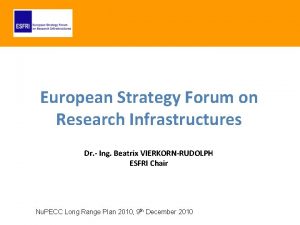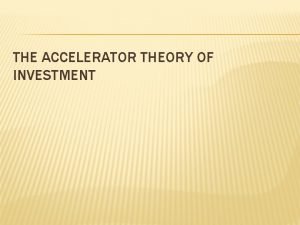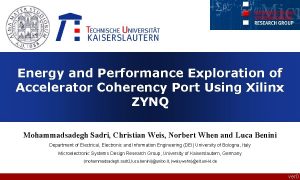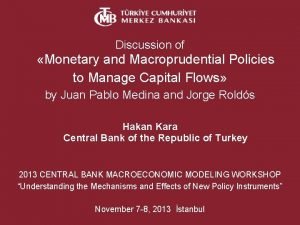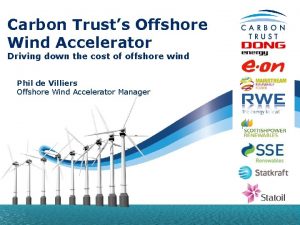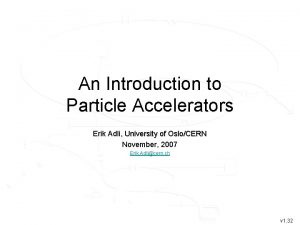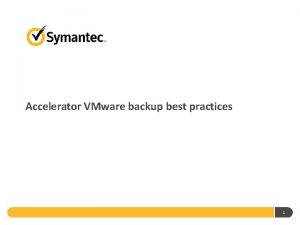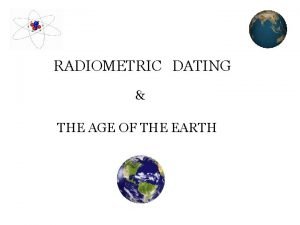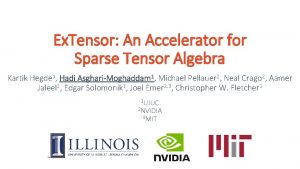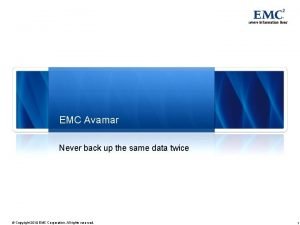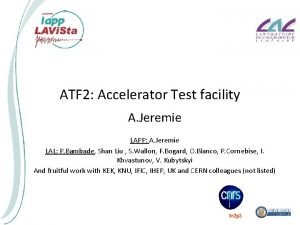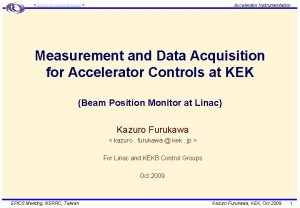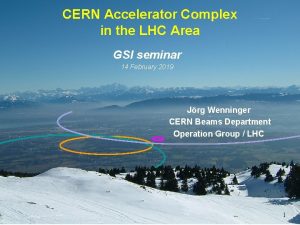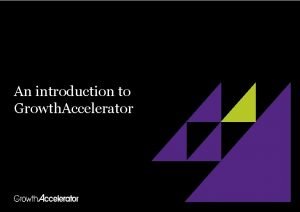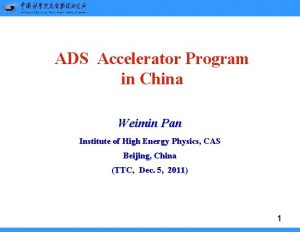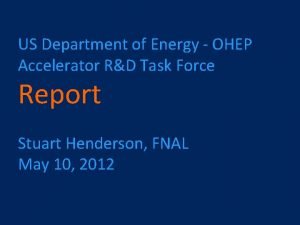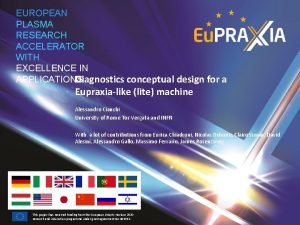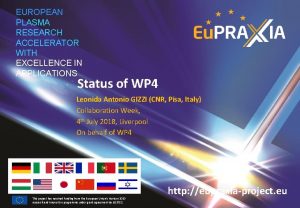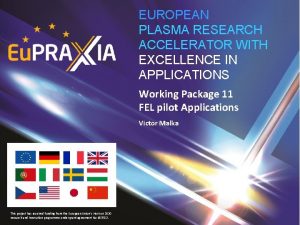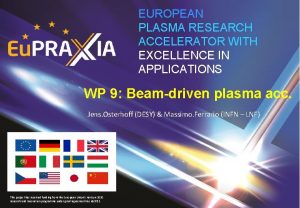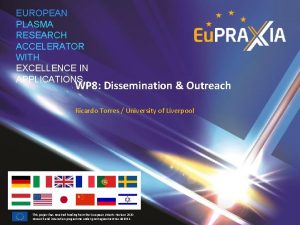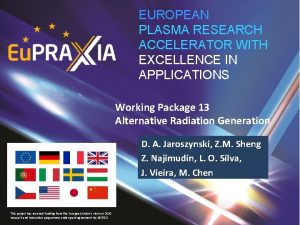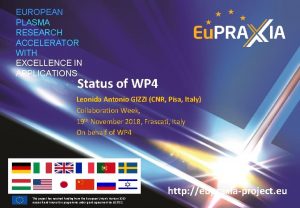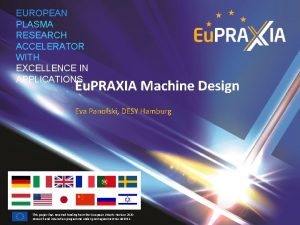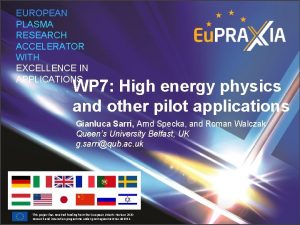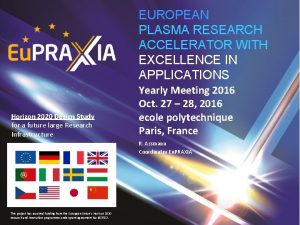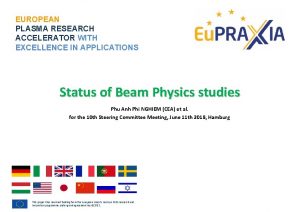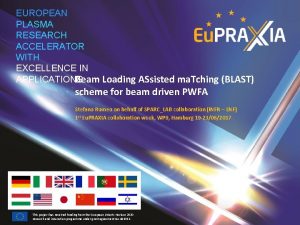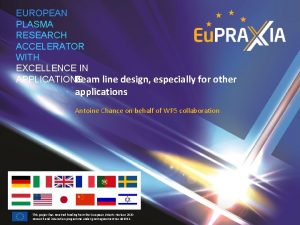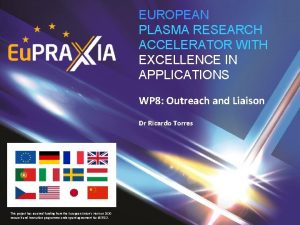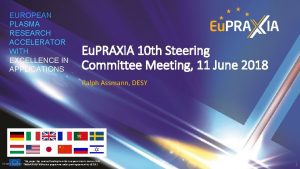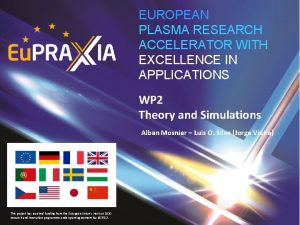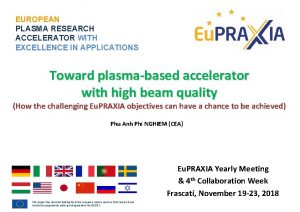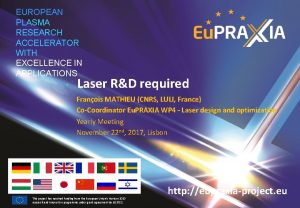EUROPEAN PLASMA RESEARCH ACCELERATOR WITH EXCELLENCE IN APPLICATIONS






























- Slides: 30

EUROPEAN PLASMA RESEARCH ACCELERATOR WITH EXCELLENCE IN APPLICATIONS Diagnostics for Eupraxia accelerator A. Cianchi (University of Rome Tor Vergata) On behalf of Eu. PRAXIA WP 5 diagnostics group This project has received funding from the European Union’s Horizon 2020 research and innovation programme under grant agreement No 653782.

Outline Horizon 2020 • This is not an overview of diagnostics. It is a result of brain storming and discussions pointing the directions in which we have to work. • Diagnostics similarities for LPWA & PWFA • Problems related with single shot transverse emittance measurements (and also small values!) • Problems related to ultra short beams • What we are doing about these problems • Conclusions Eu. PRAXIA Yearly Meeting Lisbon 2017 2

Last meeting in September Horizon 2020 • Meeting @LNF in September (remote connection was also available) https: //desycloud. desy. de/index. php/apps/files/? dir=/Eu. PRAXIA_WP 5/Diagnostics/M eetings/20170921%40 LNF&fileid=120379170 • It was the right time to define strategies and to divide the work Eu. PRAXIA Yearly Meeting Lisbon 2017 3

LWFA vs PWFA • Similar problems – Driver removal – Difficulties in capture optics – High divergence – Shot to shot instability Eu. PRAXIA Yearly Meeting Lisbon 2017 Horizon 2020

Constrains Horizon 2020 • Resolution for emittance must better than 1 mm-mrad • Time resolution must be in the fs scale • The device must work even with some instabilities, as for instance pointing, energy, time jitter • Compactness is a fundamental requirement Eu. PRAXIA Yearly Meeting Lisbon 2017

Eu. PRAXIA Diagnostics Horizon 2020 Transverse Diagnostics Longitudinal Diagnostics Charge and Trajectory Eu. PRAXIA Yearly Meeting Lisbon 2017 6

What do we want to measure? source Horizon 2020 3 cm 9 cm 15 cm M. Migliorati et al, Physical Review Special Topics, Accelerators and Beams 16, 011302 (2013) K. Floettmann, PRSTAB, 6, 034202 (2003) • The normalized rms emittance is a tricky parameter • 6 D rms emittance even is not conserved in a drift! Eu. PRAXIA Yearly Meeting Lisbon 2017

Our strategy Horizon 2020 • Separate the measurements of the source properties from the beam that it is possible to capture and transport • Use Betatron radiation in the first case • Develop single shot emittance measure in case of small energy spread (less than 1%) after the capture optics Eu. PRAXIA Yearly Meeting Lisbon 2017

Betatron radiation Horizon 2020 A. Rousse et al. “Production of a ke. V X-Ray Beam from Synchrotron Radiation in Relativistic Laser. Plasma Interaction”, PRL 93, 135005 (2004) Picture from F Albert et al Plasma Phys. Control. Fusion 56 (2014) 084015 G. R. Plateau and al. , Low-Emittance Electron Bunches from a Laser-Plasma Accelerator Measured using Single-Shot X-Ray Spectroscopy, PRL 109, 064802 (2012) Eu. PRAXIA Yearly Meeting Lisbon 2017

s s’ g Dg at the same time Source size by Fresnel diffraction • S. Kneip and al. , PRST-AB 15, 021302 (2012) Eu. PRAXIA Yearly Meeting Lisbon 2017 Horizon 2020

The correlation term Horizon 2020 • First measurement of the emittance including the correlation term • The beam profile is retrieved not simply the average dimensions • An expression is given for the correlation function between the betatron oscillation amplitude and the divergence of the single accelerated electrons, i. e. the angle with respect the acceleration axis, in order to obtain the distribution of the electron divergences. 1 J 30 fs (FWHM) 10 μm diameter focus, a 0 ∼ 4. 4 ne=(8± 1)1018 cm-3 Curcio, A. , et al. "Trace-space reconstruction of low-emittance electron beams through betatron radiation in laser-plasma accelerators. " Physical Review Accelerators and Beams 20. 1 (2017): 012801. Eu. PRAXIA Yearly Meeting Lisbon 2017

Phase space reconstruction Horizon 2020 • Normalized rms emittance (correlated): 0. 6 mm mrad • Normalized rms emittance (non correlated, upper limit): 1. 6 mm mrad Eu. PRAXIA Yearly Meeting Lisbon 2017

From 1 D to 2 D Retrieved Horizon 2020 Simulation 2 D beam profile monitor could be therefore possible only when the correlated angular-spectral distribution of the betatron radiation is detected Great monitor for nm beam size • Curcio, A. , et al. "Single-shot non-intercepting profile monitor of plasma-accelerated electron beams with nanometric resolution. " Applied Physics Letters 111. 13 (2017): 133105. Eu. PRAXIA Yearly Meeting Lisbon 2017

Open problems Horizon 2020 • Separation of Betatron radiation from Synchrotron radiation coming from a bending magnet Beam charge 30 p. C Energy 1 Ge. V plasma density 2 1016 cm− 3 magnet filed 1. 5 T radius of curvature 2. 2 m • Separation of witness and driver radiation in case of beam driven Eu. PRAXIA Yearly Meeting Lisbon 2017 INFN task 14

A new kind of Quadscan • • R. Weingartner and al. , PRST-AB 15, 111302 (2012), Barber, S. K. , et al. , Physical Review Letters 119. 10 (2017): 104801. Horizon 2020 Mostacci, A. , et al. "Chromatic effects in quadrupole scan emittance measurements. " Physical Review Special Topics -Accelerators and Beams 15. 8 (2012): 082802 no correlations between position and angle • For this measurement the energy spread is the best friend and the worse enemy! INFN task Eu. PRAXIA Yearly Meeting Lisbon 2017

Pepper pot basics Horizon 2020 To measure the emittance for a space charge dominated beam the used technique is know 1 -D pepper-pot The emittance can be reconstructed from the second momentum of the distribution C. Lejeune and J. Aubert, Adv. Electron Phys. Suppl. A 13, 159 (1980) Ludwig, T. , et al. "Quantization error of slit‐grid emittance measurement devices. " Review of scientific instruments 65. 4 (1994): 1462 -1464. ELI-Beamlines task Eu. PRAXIA Yearly Meeting Lisbon 2017

One Shot emittance Electron beam Horizon 2020 Metallic screen Beam splitter Beam imaging system + High. QE CCD Microlens array Imaging of the microlens focal plane Intensified camera, angular distribution Cianchi, A. , et al. "Transverse emittance diagnostics for high brightness electron beams. " Nuclear Instruments and Methods in Physics Research Section A: Accelerators, Spectrometers, Detectors and Associated Equipment 865 (2017): 63 -66. Eu. PRAXIA Yearly Meeting Lisbon 2017 INFN task

Effect of diffraction with energy • • • f=10 mm D=1 mm Energy=1 Ge. V • • f = microlenses focal length D= microlenses diameter Eu. PRAXIA Yearly Meeting Lisbon 2017 • • • Horizon 2020 f=10 mm D=0. 1 mm Energy=1 Ge. V F. Bisesto

Multiple OTR monitors • Horizon 2020 C. Thomas, N. Delerue and R. Bartolini “Single shot transverse emittance measurement from OTR screens in a drift transport section”, 2011 JINST 6 P 07004 • Impact of multiple scattering must be addressed • Simulation with GEANT 4 are needed LAL task Eu. PRAXIA Yearly Meeting Lisbon 2017

Eu. PRAXIA diagnostics Horizon 2020 Transverse Diagnostics Longitudinal Diagnostics Charge and Trajectory Eu. PRAXIA Yearly Meeting Lisbon 2017 20

Longitudinal diagnostics Horizon 2020 • Longitudinal diagnostics offers already attractive possibilities even in the few fs range – TDS (Transverse Deflecting Structure) – Coherent radiations – EOS (arrival time & bunch separation) – Passive streakers and plasma deflector will be considered also after experimental proof of achievable resolution Eu. PRAXIA Yearly Meeting Lisbon 2017 21

Tranverse deflecting structure • • • Horizon 2020 Conventional TDS can streak the beam in only one direction New design proposed by Grudiev can change the streaking direction It paves the way also to multi shot measurements and tomography reconstructions This new design allows for changing the streaking direction of the TDS. A. Grudiev, CLIC-note-1067 (2016) Eu. PRAXIA Yearly Meeting Lisbon 2017

System stability Horizon 2020 Expected RMS jitters: • trajectory, <σr> ~ 50 μm • arrival time, <σt> ~ 50 fs • energy spread, <σδ> ~ 0. 1% • pulse amplitude, <σA> ~ 0. 2% (defined by the modulator stability) • With the expected bunch parameters and screen stations of both FLASHForward‣‣ and FLASH 2 the allowed phase jitter of the RF system is: • RF, <σθ> ~ 0. 25 deg (X-band) • • Using this information Markus Hüning determined the temperature stability, ΔT, to be (with equal contribution from each component): Pulse compressor < 10 m. K (or 20 m. K with RF feedback gain of 1) Waveguide < 20 m. K Cavity < 20 m. K Courtesy: Richard D’Arcy X-band TDC Review Meeting | Oct 27 th, 2017 DESY task Eu. PRAXIA Yearly Meeting Lisbon 2017 23

Single shot CTR measurements Horizon 2020 Pyro-electric line detector 30 channels @ room temperature no window, works in vacuum fast read out sensitivity • S. Wesch, B. Schmidt, C. Behrens, H. Delsim-Hashemi, P. Schmuser, Nuclear Instruments and Methods in Physics Research A 665 (2011) 40 – 47 KRS-5 (thallium bromoiodide) prism based spectrometer developed • T. J. Maxwell et al. Physical review letters 111. 18 (2013) Eu. PRAXIA Yearly Meeting Lisbon 2017 Heigoldt, Matthias, et al. "Temporal evolution of longitudinal bunch profile in a laser wakefield accelerator. " Physical Review Special Topics. Accelerators and Beams 18. 12 (2015): 121302. ELI-Beamlines task

EOS Horizon 2020 • Non intercepting monitor • Resolution limited so far to 40 -50 fs • Great resource for bunch arrival time and synchronization • Online monitor for bunches separation in beam driven option • R. Pompili et al. “First single-shot and non-intercepting longitudinal bunch diagnostics for comb-like beam by means of Electro-Optic Sampling”, Nuclear Instruments and Methods in Physics Research A 740 (2014) 216– 221 Eu. PRAXIA Yearly Meeting Lisbon 2017 INFN task 25

Charge and trajectory Transverse Diagnostics Longitudinal Diagnostics Charge and Trajectory Eu. PRAXIA Yearly Meeting Lisbon 2017 Horizon 2020

Charge and trajectory Horizon 2020 m m 0 0 1 • PSI cavity BPM, frequency 3. 2844 GHz Eu. PRAXIA Yearly Meeting Lisbon 2017 16 mm • Bergoz Turbo- ICT (down to 50 f. C, up to 300 p. C) for the charge • Cavity BPM (likely C or X band) for their compactness, resolution, high S/N even at very low charge CEA task

Conclusion 1/2 Horizon 2020 • Compactness is a must, so it is needed a rethink even of ordinary diagnostics • Diffuse of cavity BPMs for trajectory measurements • Strong similarities between LWPA and PWFA in terms of diagnostics: – Driver removal – Capture optics – Large beam divergence – Energy spread mitigation if needed Eu. PRAXIA Yearly Meeting Lisbon 2017 28

Conclusion 2/2 Horizon 2020 • Longitudinal diagnostics offers already attractive possibilities even in the few fs range – TDS – Coherent radiations – Passive streakers and plasma deflector will be considered also after experimental proof of achievable resolution • Identification of a strategy for transverse emittance measurement – Betatron radiation for beam properties inside plasma – Novel diagnostics for single shot measurements only after magnetic optics, driver removal and energy spread mitigation if needed – Job assignment to the different groups Eu. PRAXIA Yearly Meeting Lisbon 2017 29

Contributors • Horizon 2020 INFN & UNITOV – Transverse single shot diagnostics – EOS – Contact person: A. Cianchi • LAL – Transverse single shot diagnostics – Smith Purcell coherent radiation – Contact person: N. Delerue • CEA – Trajectory and charge diagnostics – Contact person: C. Simon • DESY – TDS – Contact person: B. Marchetti • ELI-Beamlines – Pepper pot at moderate energy (hundreds Me. V) – Single shot longitudinal diagnostics based on coherent radiation – Contact person: A. Molodozhentsev • Cockroft institute – R&D on longitudinal and transverse diagnostics – Contact person: J. Wolfenden Eu. PRAXIA Yearly Meeting Lisbon 2017 30
 Eden european destinations of excellence
Eden european destinations of excellence Abu dhabi award for research excellence (aare)
Abu dhabi award for research excellence (aare) European strategy forum on research infrastructures
European strategy forum on research infrastructures European commission community research
European commission community research Transformational leadership questionnaire tlq
Transformational leadership questionnaire tlq Accelerator theory of investment
Accelerator theory of investment Swift biz
Swift biz Netbackup accelerator
Netbackup accelerator Econ crowding out
Econ crowding out Accelerator coherency port
Accelerator coherency port Financial accelerator
Financial accelerator Offshore wind accelerator
Offshore wind accelerator Particle accelerator formula
Particle accelerator formula Netbackup accelerator best practices
Netbackup accelerator best practices Accelerator mass spectrometry
Accelerator mass spectrometry Open capi
Open capi Extensor: an accelerator for sparse tensor algebra
Extensor: an accelerator for sparse tensor algebra Emc avamar data store
Emc avamar data store Charter network accelerator
Charter network accelerator Accelerator
Accelerator Accelerator
Accelerator Mvmc download
Mvmc download United way social innovation accelerator
United way social innovation accelerator Ccat azure accelerator
Ccat azure accelerator Cern accelerator complex
Cern accelerator complex Growth accelerator coach
Growth accelerator coach Ads accelerator
Ads accelerator Medical particle accelerator
Medical particle accelerator Pharmaceutical cpq
Pharmaceutical cpq Accelerator for r&d
Accelerator for r&d Talent accelerator program
Talent accelerator program


